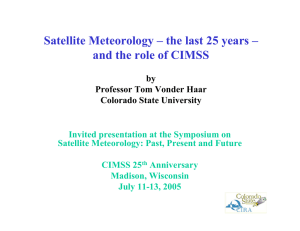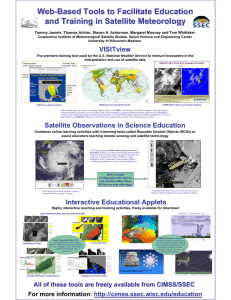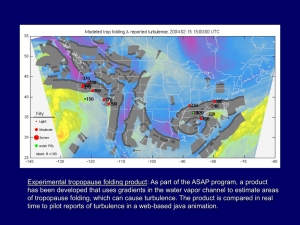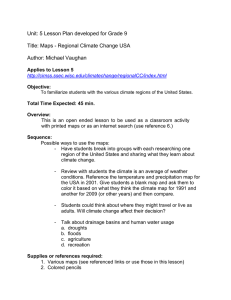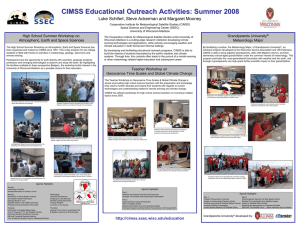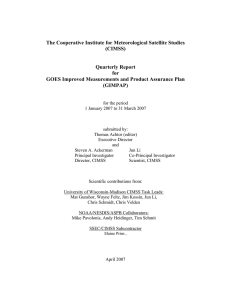The Cooperative Institute for Meteorological Satellite Studies (CIMSS) Quarterly Report
advertisement
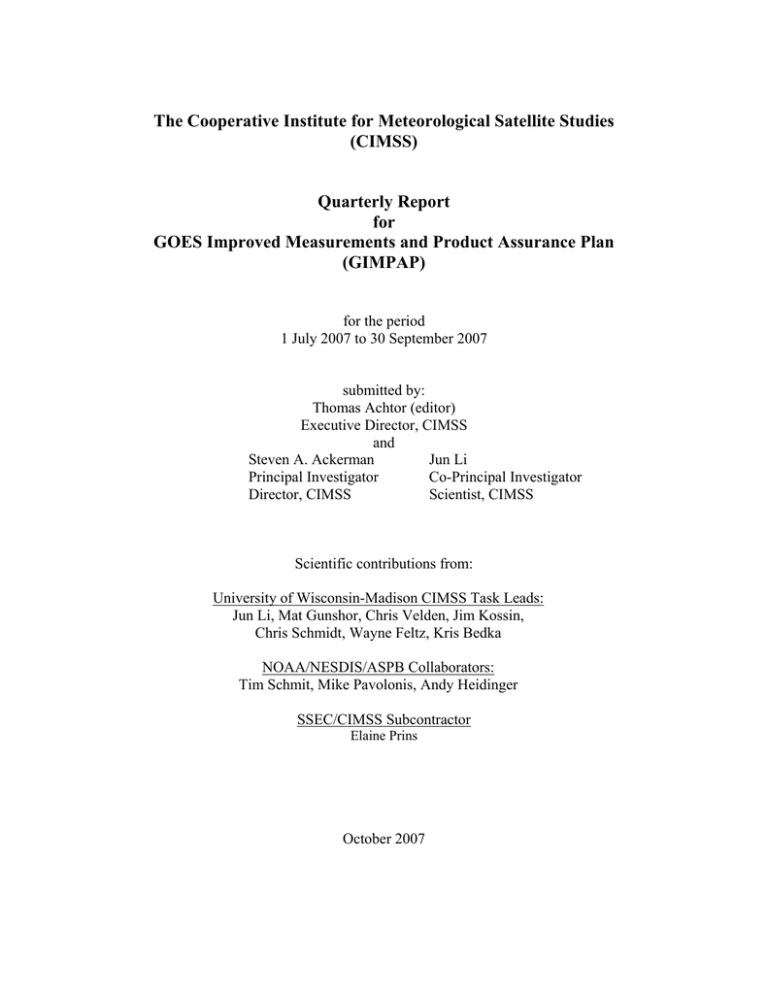
The Cooperative Institute for Meteorological Satellite Studies (CIMSS) Quarterly Report for GOES Improved Measurements and Product Assurance Plan (GIMPAP) for the period 1 July 2007 to 30 September 2007 submitted by: Thomas Achtor (editor) Executive Director, CIMSS and Steven A. Ackerman Jun Li Principal Investigator Co-Principal Investigator Director, CIMSS Scientist, CIMSS Scientific contributions from: University of Wisconsin-Madison CIMSS Task Leads: Jun Li, Mat Gunshor, Chris Velden, Jim Kossin, Chris Schmidt, Wayne Feltz, Kris Bedka NOAA/NESDIS/ASPB Collaborators: Tim Schmit, Mike Pavolonis, Andy Heidinger SSEC/CIMSS Subcontractor Elaine Prins October 2007 Quarterly Report for GOES Improved Measurements and Product Assurance Plan (GIMPAP) 1 July 2007 to 30 September 2007 Table of Contents 1. 2. Single Field-of-View (SFOV) Sounding Retrieval Science ...................................... 3 Global Observing System Studies - Intercalibration ................................................. 5 2.1 2.2 3. 4. GOES Winds ............................................................................................................. 7 GOES Tropical Cyclone Applications..................................................................... 10 4.1 4.2 5. 6. 7. Global Observing System Studies.................................................................................. 5 Intercalibration of GOES and POES.............................................................................. 6 Derived Products, ADT and Integrated Intensity Algorithms...................................... 10 GOES Imager Applications to Hurricane Intensity Change ........................................ 12 Biomass Burning Research...................................................................................... 13 GOES Imager SATellite Convection AnalySis and Tracking (SATCAST) System Product Evaluation by NOAA/NESDIS Operations ............................................... 14 Cloud Products......................................................................................................... 15 2 Quarterly Report for GOES Improved Measurements and Product Assurance Plan (GIMPAP) 1 July 2007 to 30 September 2007 1. Single Field-of-View (SFOV) Sounding Retrieval Science Lead Scientist: Jun Li GOES improved sounding algorithm and software has been successfully implemented into the CIMSS merged retrieval system The GOES improved sounding algorithm and software has been successfully implemented into the CIMSS merged real time retrieval system, the derived total precipitable water (TPW) images show that the improved DPI has less noise than the legacy algorithm. Parallel running of legacy and improved retrieval systems will be carried out for a time period for quantitative evaluation against radiosonde observations (RAOBs). The new algorithm and software can be transferred to operational implementation under PSDI program. Manuscript on improved GOES soundings and applications submitted for publication A manuscript on GOES single field of view improved sounding algorithm and applications has been submitted to Geophysical Research Letters (GRL) for publication. The paper summarizes the improved GOES sounding algorithm recently implemented into the CIMSS merged retrieval system and its potential for operational implementation. The applications of improved GOES SFOV soundings on severe weather nowcasting have been demonstrated in the manuscript. Figure 1 shows the time series of the derived LI (lifted index) imagery for the Texas Tornado case that killed 10 and injured 120. Non-cloudy areas are filled with LI values, with different colors representing different levels of severity. Cloudy areas are filled with 11 µm Brightness Temperatures (BTs); colder BTs are reflected in brighter grey shades. From the top to bottom are images for 20, 21, 22 and 23 UTC on April 24. The local time is about 10 minutes after the label time. From the left to the right is GFS forecast, legacy physical retrieval and PHYREG (the improved algorithm). One of the difficulties in forecasting such a supercell is the short lifetime of the whole system (typically just a few hours). It is very difficult for forecasters to predict where and when a supercell is going to form. In this case, it is demonstrated that the LI values in the vicinity of weather systems are well correlated with the outbreak and the development of the convective systems. At around 19 UTC, neither the 11 µm imagery (no cold clouds) nor the LI DPI imagery (not shown here) indicates that a severe convective storm is developing. However, one hour later, the LI DPI imagery (and hence the PHYREG retrievals) changes dramatically from “marginally unstable” to “moderately unstable” and “very unstable” (the red region among the yellow area in Figure 1c). This indicates a more favorable pre-convective environment. The same degree of convective potential (in terms of coverage) is not seen on either the GFS forecast or the legacy retrieval DPI imagery at 20 UTC (Figure 1a and 1b). The GOES Imager animation [ http://wwwangler.larc.nasa.gov/armsgp/g8usa.html/ ] shows the outbreak of the supercell occurring immediately prior to 2015 UTC. Note that the cloud top BT was less than 220K in 11 µm imagery at 21 UTC. During the next several hours, the supercell grew rapidly, and the center of the cell moved southeast along the border. Compared with the GFS forecast, the legacy retrievals reveal increasing areas of instability surrounding the supercell; the improved retrievals are even more extended and pronounced. Figure 1o shows three areas of large negative LI values. To the south of the supercell the instabilities ensured the continuous growth of the supercell. To the northwest of the supercell, the instabilities initialized (between 22 and 23 UTC) and maintained 3 another convective storm to the north of the supercell. To the west of the supercell, the instabilities initialized (between 01 and 02 UTC, not shown) and maintained a third convective storm. Not shown here are the instabilities that returned to normal values during the post-stage of the convective storms. More details on applications of improved GOES SFOV soundings can be found in Li et al. paper which is available upon request. Figure 1. Time series of LI DPI imagery on 24 April 2007. From top to bottom is 20, 21, 22, 23 and 00 UTC. From the left to the right is GFS forecast, the legacy retrieval and PHYREG. A tornado touched down near Eagle Pass, Texas (the green X along the Texas/Mexico border within the supercell in the bottom three panels) around 00 UTC. Related presentations and publications: 1 July – 30 September 2007 (1) Jun Li attended EUMETSAT/AMS joint satellite conference held from 24 to 28 September 2007 in Amsterdam, The Netherlands, he gave an oral presentation titled “Single Field-of-View Soundings from Geostationary Infrared Sounder Radiances” (2) Li, Zhenglong, W. P. Menzel, T. J. Schmit, J. P. Nelson, J. Daniels, and S. A. Ackerman, 2007: GOES sounding improvement and applications to severe storm nowcasting, Geophysical Research Letters (submitted). (3) Li, Jun. et al. 2007: GOES Sounding Product Improvement and Applications to Storm Cases, supplementary PPT for GIMAP TAC. 4 2. Global Observing System Studies - Intercalibration Lead Scientists: Mat Gunshor, Tim Schmit 2.1 Global Observing System Studies Background The primary purpose of the intercalibration project is to compare select infrared channels on geostationary instruments (GOES, Meteosat, etc) with those obtained from polar-orbiting instruments (NOAA AVHRR and HIRS, EOS AIRS). This proposal covers research into new/improved methods, testing new satellite instruments, diagnosing problems on existing instruments, and the analysis and presentation of results. Summary Research done this year to improve the AIRS spectral gap filling technique culminated in a paper submitted to the SPIE. Results were presented as a poster at the SPIE conference: Atmospheric and Environmental Remote Sensing Data Processing and Utilization III: Readiness for GEOSS, which was held on 27-28 August, 2007. The paper was titled “Intercalibrating geostationary imagers via polar orbiting high spectral resolution data” and included results from GOES-12 and Meteosat-8 compared to AIRS over 2006. The method used for compensating for AIRS spectral gaps is to fill them with generic information from the US Standard Atmosphere, adjusted to mimic the AIRS data (see Figure 2). Part of the paper focuses on this method and testing it against a series of known atmospheres (calculated spectra from radiosonde data using a line-byline radiative transfer model) which were made to look like AIRS. The results showed that the method worked very well for most of the spectral bands, and reasonably well in tropical atmospheres for the other bands. This research was also presented at the 15th American Meteorological Society (AMS) Satellite Meteorology & Oceanography Conference in Amsterdam, the Netherlands 24-28 September, 2007. This was a joint conference with the 2007 EUMETSAT Meteorological Satellite Conference. The poster presented in Amsterdam covered the same material as the one presented in San Diego for the SPIE conference in August and was presented by a NOAA co-author traveling under other funding. Work has begun to bring in IASI data for comparisons to the world’s geostationary imagers. At the same time, work also continues to expand the SPIE paper into a refereed journal article. The journal article will expand on the methods and include results with not only GOES-12 and MET8, but also the imagers on GOES-10, GOES-11, MET-9, MTSAT-1R, and FY-2C. 5 Figure 2: Example of AIRS spectral gaps being filled in blue by an adjusted US Standard Atmosphere spectrum. Publications Gunshor, Mathew M.; Schmit, Timothy J.; Menzel, W.P, and Tobin, David. Intercalibrating geostationary imagers via polar orbiting high spectral resolution data. Atmospheric and Environmental Remote Sensing Data Processing and Utilization III: Readiness for GEOSS, San Diego, CA, 27-28, & 30 August 2007. Proc. SPIE Int. Soc. Opt. Eng. 6684, 66841H (2007). 2.2 Intercalibration of GOES and POES Background Calibration and instrument intercomparison are the main methods by which individual instruments can be validated against one another between the geostationary and polar orbiting platforms. Routine automated intercalibration provides information on how operational geostationary environmental satellites around the globe compare radiometrically. CIMSS has been intercalibrating satellite instruments routinely since 1999 and the methodology is documented in the research journal literature (Gunshor et al. 2004). Research into new/improved methods, testing new satellite instruments, diagnosing problems on existing instruments, and the analysis and presentation of results are covered under the broader Global Observing System Studies section. This section of the proposal covers the routine production of results, the routine posting of results on the World Wide Web, software maintenance, and the implementation of knowledge gained from the research done under the broader Global Observing System Studies section. 6 The primary purpose of the Intercalibration of GOES and POES project is to compare the infrared window, water vapor, and 13.3 micrometer CO2-absorption band channels on geostationary instruments (e.g. GOES, Meteosat) by using the same spectral bands on polar-orbiting instruments (e.g. NOAA AVHRR and HIRS). This task is accomplished by making multiple comparisons at the geostationary sub-satellite points and finding an average brightness temperature difference between the geostationary and the polar orbiter spectral bands. Comparison of satellite radiances leading to an improved knowledge of calibration is important for various global applications of satellite data where data from more than one instrument are combined for a single purpose. The CGMS (Coordination Group for Meteorological Satellites) has requested satellite operators to regularly perform satellite intercalibration. The World Meteorological Organization (WMO) has initiated a global intercalibration project called the Global Space-based Intercalibration System (GSICS) with NOAA/NESDIS as a lead agency. This intercalibration work directly supports this international collaboration among satellite providers. Summary Regular oversight of the automated features of this task was the primary function this quarter. The data collection and processing results were monitored as well as the output generated for the internet. In addition, we have switched to MTSAT HRIT data from MTSAT HiRID data formats. This change was necessary due to NESDIS dropping the HiRID format and switching to HRIT. This change meant upgrading the portion of the intercalibration software that runs in McIDAS. McIDAS is used to collect data for intercalibration and older versions of the McIDAS servers cannot properly handle this newer data format for MTSAT. Version 2005a of the McIDAS had been utilized, but now the 2007 version of McIDAS is being run. A further upgrade to version 2007a, released at about the same time this quarterly report was written, will be required. In the past there are have been issues with some McIDAS upgrades where some software did not compile or work properly. Hence upgrades such as this one require close monitoring and sometimes revisions to the software. At the time of this report, it appears this upgrade went smoothly and is not causing any problems. It remains to be seen if switching MTSAT data formats will affect intercalibration results. 3. GOES Winds Lead Scientist: Chris Velden Accomplishments over the past 3-months include (but are not limited to): Quality Indicator The data assimilation community continues to struggle with effective integration of satellitederived winds into current variational analysis schemes. As a result, observing system experiments show the winds offer only a modest positive impact on NWP forecasts. We continue to test a new regression-based quality indicator referred to as the “Expected Error” (EE). This index is designed to attach to every vector record and indicate the confidence in the form of an expected vector RMSE. Our analyses suggest the EE is a better indicator of quality than the existing operational quality indicators. During this quarter, we examined this new EE for data assimilation screening properties, and 7 possibly for the replacement of the cumbersome auto-editor and recursive filter quality flag. Experiments were performed to investigate the impact of the EE on CIMSS quality control processing, and to test if the EE could be used to create a dataset that is statistically comparable to the currently-employed recursive filter (RF) analysis. Thus, a pre-RF dataset and a post-RF dataset consisting of a large volume of GOES-12 winds were matched in space and time (150 km, 25 hPa, 1-h) with RAOBS (Table 1). From the table, you can see the RF effectively reduces the RMS vector differences (compared to RAOBS) at all levels. Given this benchmark, can the EE be used to create a wind set with comparable quality? Table 2 addresses this question. As shown in Table 2, when the EE is lowered, the RMS differences between AMVs and RAOBS significantly decreases. AMVs with EEs less than 6 generally produce a lower RMS difference than the post-RF dataset. However, the number of vectors retained in the dataset is also reduced compared to the RF. This will be a subject of future research. Dataset Height (hpa) Number Spd Bias RMS Vector Difference Pre-RF Post-RF 100 – 400 22622 23133 400 – 700 3638 3399 700 –1000 1649 1377 100 – 400 -1.15 -0.33 400 – 700 -0.55 -1.06 700 - 1000 -0.14 -0.42 100 – 400 7.50 6.97 400 – 700 5.86 5.39 700 - 1000 4.70 4.63 Table 1: Bulk statistics comparing the collocated pre- and post RF GOES-12 AMV datasets as compared to collocated RAOBS. The RF lowers the RMS differences as compared to RAOBS for all tropospheric layers (three are shown), thereby effectively increasing the quality of the dataset. Expected Error Max Number 100 - 400 of 400 - 700 matches 700-1000 Spd Bias 100 - 400 (AMV Š 400 - 700 RAOB) 700-1000 RMS 100 - 400 Vector 400 - 700 Diff. 700-1000 (vs RAOB) 3 993 328 718 -1.17 -1.05 -0.45 5.02 4.36 3.91 4 4370 1169 1173 -1.33 -1.02 -0.49 5.58 4.72 4.15 5 10048 2141 1464 -1.49 -1.06 -0.32 6.23 5.18 4.45 6 16012 2943 1602 -1.46 -0.91 -0.22 6.71 5.39 4.63 7 19705 3317 1638 -1.36 -0.82 -0.17 7.04 5.51 4.68 8 21519 3490 1646 -1.25 -0.79 -0.14 7.24 5.62 4.69 9 22181 3553 1649 -1.24 -0.75 -0.14 7.36 5.68 4.70 10 22462 3597 1649 -1.20 -0.68 -0.14 7.44 5.74 4.70 11 22579 3616 1649 -1.16 -0.63 -0.14 7.48 5.78 4.70 12 22607 3626 1649 -1.15 -0.61 -0.14 7.49 5.80 4.70 Table 2: AMV-RAOB statistics for the pre-RF data as thresholded by a maximum EE. Lowering the EE reduces the RMS vector difference. 8 AMV Height Assignment We have taken a fresh look at the height assignments of atmospheric motion vectors, or AMVs (including GOES). Instead of treating the AMVs as representing discrete levels, our analysis has focused on tropospheric layers. Using collocated rawinsonde and wind profilers, large samples GOES AMV datasets are matched to the vertical wind profiles, and a “layer of best fit” (minimization of RMSE) is identified. Our results show clearly that the AMVs matched to rawinsonde layers yield significantly lower differences then the levels to which they were originally assigned. The matches have been broken down by wind type and height assignment method, to better characterize the height assignment traits by layers (Figure 3). This work was recently presented at the AMS Satellite Conference, and a journal publication is being prepared. Figure 3. The GOES AMV-rawinsonde comparisons are plotted as VRMS differences for the various rawinsonde wind averaged over the layer thickness categories (10-300hPa, in 10hPa increments), and are represented by the curves (with the corresponding single level-based VRMS values plotted on the y-axis), and for various cloud height assignment methods. 9 4. GOES Tropical Cyclone Applications Lead Scientists: Chris Velden (4.1), Jim Kossin (4.2) 4.1 Derived Products, ADT and Integrated Intensity Algorithms Lead Scientist: Chris Velden Accomplishments over the past 3 months include (but are not limited to): GOES Derived Diagnostic Fields for TCs The CIMSS Tropical Cyclones (TC) group continues to develop diagnostic fields derived from GOES winds analyses for applications to TCs. These products include analyses of vertical wind shear, vorticity, upper-level divergence, vertical wind shear tendency, steering currents, and surface adjusted cloud-drift winds. All of these products are featured on the CIMSS Tropical Cyclones web site, which has become an extremely popular “public outreach” site for the general public, researchers, and forecasters during TC events. During this reporting period we have continued working on a new innovative web page site that will allow increased user interaction and visualization capabilities: http://cimss.ssec.wisc.edu/tropic2 Also, GOES datasets and products are continuously requested and provided to the user community for expanding scientific research on TCs. Therefore, we are scoping the development of an on-line GOES TC product archive. Advanced Dvorak Technique We continue to conduct basic research and upgrade the Advanced Dvorak Technique (ADT) algorithm, which is now used by several NOAA and DoD tropical cyclone analysis centers. Our latest research has focused on the utilization of an additional geostationary satellite channel to augment the current ADT methodology. Using a difference between the water vapor and longwave infrared window channels, strong TC convection can be identified and quantified to aid with TC center determination (Figure 4) and intensity estimate determination (Figure 5) within the ADT. We also continue to work to ensure (through GPSDI funding) that the latest versions are available to NESDIS/SAB and NOAA/TPC and CPHC. More information can be found at: http://cimss.ssec.wisc.edu/tropic2/misc/adt . 10 Storm Center Figure 4: Corresponding TC images of enhanced IR (left) and derived IR-WV (right). IRWV image identifies TC storm center not apparent in enhanced IR image. Figure 5: Time series of aircraft reconnaissance MSLP (black) versus IR-WV histogram bin amounts (magenta: all values less than 0°C; cyan: all values between -1°C and 0°C) 11 Integrated Approach to TC Intensity Estimation The CIMSS TC group continues to explore an integrated approach to satellite-based TC intensity estimation through a weighted consensus of satellite-based ADT, and AMSU methods derived at CIMSS and at CIRA. The approach (SATCON) has first identified the strengths and weaknesses of each individual method, which is then used to assign weights towards a consensus algorithm designed to better estimate TC intensity. A statistical analysis reveals the approach is superior to the independent algorithms evaluated alone. In this reporting period we have investigated a cross-platform approach that uses information derived from the estimate methods (CLW, AMSUB 89 GHz, ADT Eye temps and RMW) to make adjustments to the individual members. Once these adjustments are made we then apply the weighting scheme. This has resulted in an improvement in skill compared to simply weighting the members with no adjustments (see Table 3 below). The fundamental error sources of the methods have not changed with the latest upgrades of the members so the original weighting decision tree remains and the weights themselves have not been changed (at least not yet). The focus now is on displaying the information in a way that is most meaningful to the users and tweaking the real-time code. This new approach will be tested in near real time during the 2007 hurricane season. For more information, see: http://cimss.ssec.wisc.edu/tropic/satcon/satcon.html N= 258 CIMSS AMSU ADT CIRA AMSU SIMPLE AVG SATCON SATCON WITH INFO SHARING BIAS -3.9 -4.9 -7.3 -4.7 -3.9 -1.1 ABS ERR 8.9 12.3 11.1 8.7 8 7.1 RMSE 11.2 16.1 15 11.1 10.3 9.3 Table 3. Maximum Sustained Wind (MSW) estimate performance using reconnaissance aircraft data for ground truth of individual members compared to a simple average of the members, SATCON and SATCON using cross-platform information sharing. All units in knots. 4.2 GOES Imager Applications to Hurricane Intensity Change Lead Scientist: Jim Kossin Project Description: The goal of this research is to extract more information from GOES IR imagery that is related to hurricane intensity change, and apply this information to increasing intensity forecast skill through modification of the SHIPS model and construction of a new Rapid Intensification Index algorithm. Accomplishments in the last three months There were no charges of any kind applied to this project during this quarter, but progress was made in further construction and quality control of the data needed for the next phase of the project. Progress in general is sometimes put on hold as we wait for NCDC personnel to fix satellite data issues that arise during our analyses. This is to be somewhat expected with such a large and unprecedented dataset, and we’re confident that the data QC is very nearly completed. During the next quarter, we plan to complete the extension of the SHIPS-IR dataset and begin the construction of the feature matrices that will be used in the Rapid Intensification classification algorithm (based on Bayesian classification). 12 5. Biomass Burning Research Lead Scientists: Elaine Prins, Chris Schmidt The UW-Madison CIMSS burning team proposed four major tasks for 2007. CIMSS proposed to continue the GOES WF_ABBA trend analysis throughout the western hemisphere to assess changes in biomass burning and collaborate with the user community in environmental applications of the WF_ABBA data base. These collaborations include ongoing activities with the atmospheric modeling community to assimilate geostationary WF_ABBA fire products into aerosol/trace gas transport models. A new effort in collaboration with Dr. R. Rabin (NOAA/NSSL) and Dr. P. Bothwell (NOAA/NWS, Storm Prediction Center) focuses on applications of Rapid Scan GOES fire products for early detection of wildfires and agricultural burning and diurnal monitoring of fire variability. Finally, CIMSS proposed to continue to work with GTOS GOFC/GOLD, CGMS, and GEOSS to foster the development and implementation of a global geostationary fire monitoring network with international involvement. Accomplishments: The CIMSS biomass burning team continues to collaborate with the international aerosol/emissions modeling and data assimilation communities. Our most active collaborations during the past quarter were with NRL-Monterey FNMOC and the air quality transport modeling team at INPE/CPTEC in Brazil. In collaboration with Dr. R. Rabin (NOAA/NSSL) and Dr. P. Bothwell (NOAA/NWS, Storm Prediction Center) CIMSS continued to evaluate time series of rapid scan observations of wildfire activity and ancillary information (local meteorological conditions and fire observations if available). A more in-depth analysis was performed on the Westside Fire in southern California that occurred in December 2006. Unfortunately detailed observations of the Westside fire are not available from local fire fighting officials in Kern County, CA for the first day of the fire when rapid scan observations were available. There is some anecdotal information, but it does not coincide with what is observed in the satellite imagery. Although there are some interesting developments in the observed brightness temperatures and fire radiative power (FRP), including a couple of spikes in the power difference, there does not appear to be any relation between power difference and the meteorological parameters. Based on this preliminary analysis more case studies are needed to further explore this application. CIMSS continues to work with the GTOS GOFC/GOLD Fire Implementation Team as the lead on global geostationary fire monitoring network activities. This activity also fits within the framework of GEOSS and falls under the GEO Tasks DI-06-13 and DI-06-09. A paper titled “Global Observation of Forest and Land Cover Dynamics (GOFC-GOLD): monitoring and early warning systems for wildland fire disaster reduction” was accepted for publication in the Group on Earth Observations (GEO) Summit Publication, The Full Picture. The article discusses global near-real time wildland fire monitoring from both polar and geostationary systems and the development of a global early warning system for wildland fire. Co-authors include representatives from Natural Resources Canada, the University of Maryland, U. W. Madison CIMSS, and the Global Fire Monitoring Center. Reports de Groot, W., T. Lynham, M. Brady, I. Csiszar, D. Davies, C. Justice, E. Prins, and J. Goldammer, 2007: Global Observation of Forest and Land Cover Dynamics (GOFC-GOLD): monitoring and early warning systems for wildland fire disaster reduction. To be published in the Group on Earth Observations (GEO) Summit Publication: The Full Picture. 13 6. GOES Imager SATellite Convection AnalySis and Tracking (SATCAST) System Product Evaluation by NOAA/NESDIS Operations Lead Scientists: Wayne Feltz, Kris Bedka Background CIMSS, in collaboration with the University of Alabama-Huntsville, currently produces a set of GOES-12 Imager satellite-derived products for diagnosing and nowcasting thunderstorm development, evolution, and motion. These products have been under development for four years under the NASA-supported Advanced Satellite Aviation-weather Products initiative for use in aviation safety applications (Mecikalski et al., 2006). CIMSS is currently providing these products to several groups, including the NOAA/NESDIS Satellite Application Branch (SAB) precipitation desk, in near real-time. The goal of this collaboration is to improve upon existing SAB satellite-derived guidance and precipitation forecasts. CIMSS convective weather products can identify rapidly developing convective storms, which should be monitored for heavy rainfall and flash flooding potential. SAB precipitation estimates are provided directly to National Weather Service Forecast Offices and Regional Forecast Centers and contribute to forecasts disseminated to the general public. The use of geostationary satellite imagery provides a clear advantage over operational NWP model guidance for short-term convective weather forecasting, as satellites observe the true state and evolution of a convective event at high temporal/spatial resolution, whereas NWP models often incorrectly simulate the timing and location of convective storm development. Satellitederived products also have an advantage over WSR-88D radar products in that convective storm initiation is observed in satellite imagery before precipitation echoes are detectable by radar, providing valuable lead time for operational forecasters. Accomplishments 1) Wayne Feltz and Kristopher Bedka visited NOAA NESDIS SAB branch on August 29-30, 2007 to discuss optimal display, NWS end-user feedback, data interpretation, and plans for FY2008. Convective initiation algorithm testing is ongoing. A new box-average cooling rate field is now being provided to NOAA SAB for user evaluation. 2) A training PowerPoint has been constructed and provided to interested uses, including the NOAA NESDIS SAB team. 3) The software continues to operate on larger real-time domains. The CI domain is operating in two modes. First over Storm Prediction Center (SPC) convective risk domains and second over the upper Midwest in support of local forecast offices. SATCast is now operating over AWIPS Upper Midwest “States” domain. Cooling rate and convective initiation results are being evaluated locally at CIMSS prior to distribution to local NWS office. A new cooling rate technique using radiance box averaging has been developed to improve product temporal latency and reduce false alarm rate. 4) We continue to work with local NWS offices (Sullivan, Green Bay, and La Crosse) to acquire user feedback and improve upon products where necessary. Kristopher Bedka and Jordan Gerth attended the NWS Great Lakes Operational Meteorologist Workshop Sept 5-7, 2007 to present the GOES satellite-derived mesoscale winds and convective initiation. Green Bay NWS has invited us to visit in October 2007 to present work. Further evaluation of new convective initiation box averaging method is continuing and initial validation is ongoing. 14 5) We are coordinating with scientists at NSSL and CIRA on CIMSS aviation activities. Wayne Feltz conducted a coordination telcon on August 23, 2007 with Dan Lindsey at CIRA to touch base on both cooperative institutes convective research. 7. Cloud Products Lead Scientists: Mike Pavolonis, Andy Heidinger Brief Description of work proposed With the advent of the GOES-R Algorithm Working Groups, NOAA has begun to develop consensus prototype algorithms for GOES-R. Particularly, the cloud application team has developed a prototype system for testing cloud algorithms applied to geostationary imager data (GEOCAT). GEOCAT can process geostationary imager data from GOES, MSG/SEVIRI and MTSAT. Beyond the cloud height and effective cloud amount product from the GOES-12 imagers and the cloud mask from Clear-sky Brightness Temperature (CSBT), NOAA makes no other operational cloud products from the GOES imager. Most of the proposed GOES-R cloud products can in fact be produced from the current GOES imagers albeit with reduced accuracy. We propose therefore to implement GEOCAT applied to the GOES imager data in real-time at CIMSS and to make cloud products available to all interested users for evaluation and comment. Summary of Results for Past Quarter This quarter we focused on setting up our real-time GOES processing. GEOCAT has been processing GOES-11 data in real-time continuously since the end of July 2007 (see Figure 6 below). The results have been encouraging in that the system has not experienced any noticeable disruptions and the processing time has been consistently under 2-minutes per full disk. Currently we are running the cloud mask, but we are in the process of adding the cloud phase and cloud optical property algorithms that were developed for GOES-R. Of course the GOES-R algorithms will need to be adjusted since some of the channels used in the algorithms are not available on the current GOES Imagers. We expect to have all of the GOES algorithms running, with the results displayed online, by the end of the fourth quarter. 15 Figure 6: Example cloud mask/surface temperature product (bottom) from the real-time GEOCAT-based processing system. White indicates the presence of clouds while all other colors indicate the surface temperature. The example shown here is from GOES-11 on August 5, 2007 at 1130 UTC. The corresponding infrared image is also shown in the top panel. 16
